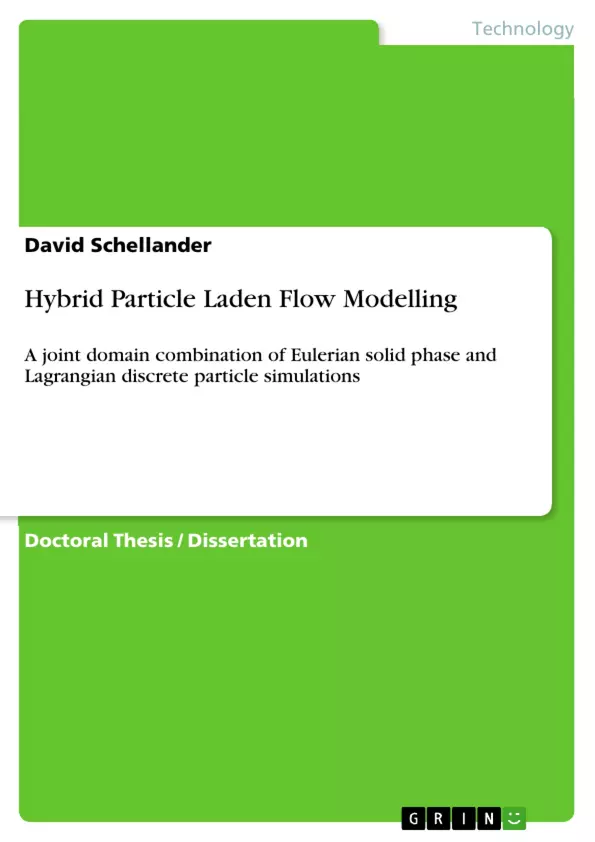The numerical hybrid model EUgran+, which is an Eulerian-Eulerian granular phase model extended with models from the Eulerian-Lagrangian model for dense rapid particulate flows, is modified to account for poly-dispersed particle diameter distributions. These modifications include the implementation of I) a new poly-dispersed drag law and of II) new particle boundary conditions distinguishing between sliding and non-sliding particle-wall collisions and III) a new implementation of the population balance equation in the agglomeration model using the Eulerian-Lagrangian approach, referred to as Bus-stop model. Further, the applicability of the EUgran+ model is extended to cover dilute to dense poly-disperse particulate flows. Furthermore, this provides an improvement in the numerical simulation of dust separation and the formation of particle strands in industrial scale cyclones. In this PHD thesis, the EUgran+Poly model is validated at 3 specific cases with different mass loadings: I) poly-dispersed particle conveying in a square pipe with a 90 degree bend at low mass loading (L = 0:00206); II) a particle conveying case in a rectangular pipe with a double-loop at high mass loading (L = 1:5); III) in a vertical pipe the implementation of the agglomeration model is validated. To show the applicability of the presented models a simulation of an industrial cyclone in experimental scale is presented. The validation and application shows that considering a poly-disperse Eulerian-Eulerian granular phase improves the accordance of the simulation results with measurements significantly. Finally, the hybrid model is a good compromise for a computational efficient simulation of particulate transport and separation with different mass loading regimes.
Table of Contents
- Abstract
- Zusammenfassung
- 1 Introduction
- 1.1 Motivation
- 1.2 Objective
- 1.3 Structure of the Thesis
- 2 Fundamentals
- 2.1 Governing Equations for Fluid Flow
- 2.2 Discrete Particle Modelling
- 2.3 Eulerian-Lagrangian Coupling
- 3 Numerical Methods
- 3.1 Finite Volume Method
- 3.2 Discrete Element Method
- 3.3 Coupling Approaches
- 4 Validation and Application
- 4.1 Validation Cases
- 4.2 Industrial Application
- 5 Conclusion
- List of Symbols
- References
Objectives and Key Themes
This dissertation focuses on developing a hybrid numerical method for modeling particle-laden flows. The main objective is to combine the advantages of Eulerian and Lagrangian approaches to achieve a more accurate and efficient simulation method. Key themes explored in the dissertation include:- Development of a hybrid particle-laden flow model
- Integration of Eulerian and Lagrangian simulation techniques
- Validation of the model against experimental data
- Application of the model to industrial problems
- Analysis of the influence of particle properties and flow conditions on the simulation results
Chapter Summaries
Chapter 1 introduces the motivation and objective of the dissertation. It provides a brief overview of particle-laden flows and the challenges associated with their simulation. The chapter also outlines the structure of the thesis. Chapter 2 reviews the fundamental equations governing fluid flow and introduces the concepts of discrete particle modeling and Eulerian-Lagrangian coupling. It discusses the advantages and disadvantages of different modeling approaches. Chapter 3 describes the numerical methods used in the dissertation. It presents details about the finite volume method for solving the fluid flow equations and the discrete element method for simulating particle motion. It also discusses various coupling approaches for integrating the two methods. Chapter 4 focuses on the validation and application of the developed hybrid model. It presents validation cases using experimental data and an industrial application of the model.
Keywords
The primary focus of this dissertation is on particle-laden flows, hybrid modeling techniques, Eulerian-Lagrangian coupling, finite volume method, discrete element method, validation, and industrial applications. The work investigates the development and application of a comprehensive model for simulating complex multiphase flows involving particles.- Citar trabajo
- David Schellander (Autor), 2013, Hybrid Particle Laden Flow Modelling, Múnich, GRIN Verlag, https://www.grin.com/document/233622



